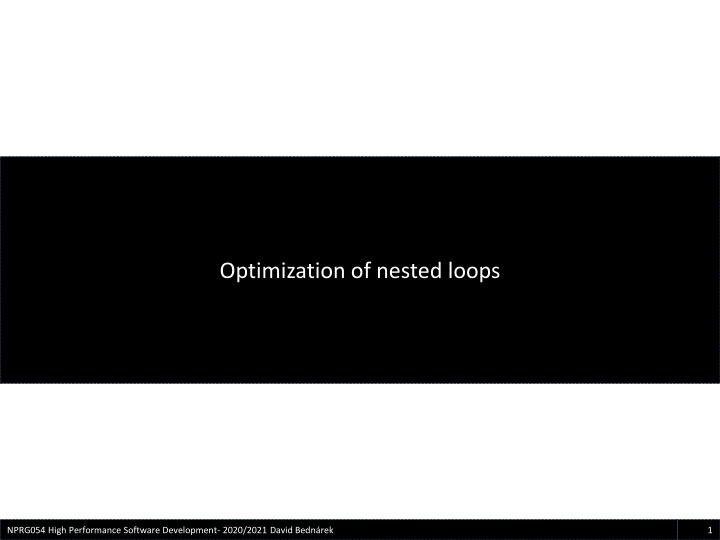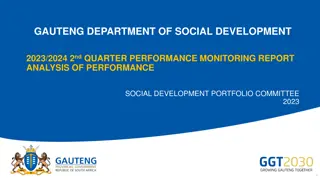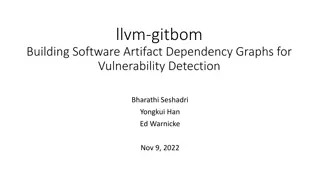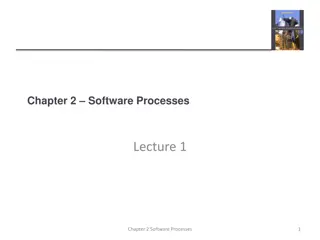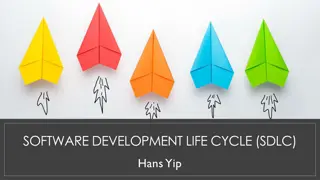Dependency Analysis in High-Performance Software Development
Dependency analysis in software development involves understanding the relationships between instructions and data, optimizing nested loops, and addressing critical dependency cycles. This process helps enhance performance and efficiency in software systems.
Download Presentation

Please find below an Image/Link to download the presentation.
The content on the website is provided AS IS for your information and personal use only. It may not be sold, licensed, or shared on other websites without obtaining consent from the author.If you encounter any issues during the download, it is possible that the publisher has removed the file from their server.
You are allowed to download the files provided on this website for personal or commercial use, subject to the condition that they are used lawfully. All files are the property of their respective owners.
The content on the website is provided AS IS for your information and personal use only. It may not be sold, licensed, or shared on other websites without obtaining consent from the author.
E N D
Presentation Transcript
Optimization of nested loops NPRG054 High Performance Software Development- 2020/2021 David Bedn rek 1
Dependency analysis Dependency The need to execute one instruction after another Associated with a latency = the minimal time difference between the instructions Partial ordering of instructions Data dependency passing a value through a (temporary) variable Write-Read Anti-dependency no value passed but protecting the effect Read-Write Write-Write Control dependency Condition-Operation: Waiting to confirm that the operation is requested For operations that cannot be undone writing memory, possible faults, ... Usually analyzed over a loop 2 NPRG054 High Performance Software Development- 2016/2017 David Bedn rek
Example char chksum( char * rp, int ri) { char rs = 0; while ( ri > 0 ) { 1 0 2 char r1 = *rp++; mov r1,[rp] 0 2 rs ^= r1; inc rp 4 2 --ri; dec ri xor rs,r1 1 } 2 cmp ri,0 return rs; 1 0 2 jgt } Dependencies inside an iteration across iterations Cyclic graph NPRG054 High Performance Software Development- 2016/2017 David Bedn rek 3
Example vector-by-matrix multiplication Critical dependency cycle The cycle with the greatest latency for J := 1 to M do for K := 1 to N do Alternating reading and writing of the same element C[J] An inner loop iteration can never be faster than the latency of the read operation C[J] := C[J] + A[J]*B[J,K] for J := 1 to M do begin The latency of writes is usually 0 S := C[J] Transformation to a local variable placed in a register for K := 1 to N do S := S + A[J]*B[J,K] Note: this is not an equivalent transformation if C and A may be aliased Improves latency but does not remove the critical dependency cycle C[J] := S end Loop reversal for K := 1 to N do Not equivalent in the presence of aliasing Removes the dependency cycle completely for J := 1 to M do C[J] := C[J] + A[J]*B[J,K] It is now present in the outer loop NPRG054 High Performance Software Development- 2020/2021 David Bedn rek 4
Loop reversal The original pass through the iteration space Iteration space = possible combinations of control-variable values Most neighbors are dependent J K 5 NPRG054 High Performance Software Development- 2020/2021 David Bedn rek
Loop reversal The order after the loop reversal Most neighbors are independent J K 6 NPRG054 High Performance Software Development- 2020/2021 David Bedn rek
Parallel bsearch for ( i = 0; i < N; ++ i ) bsearch_many( a, M, b, N); bsearch( a, M, b[ i]); void bsearch_many( a, M, b, N) void bsearch( a, M, x) { { while ( /*???*/ ) while ( /*...*/ ) for ( i = 0; i < N; ++ i ) { { if ( a[ j] > x ) if ( a[ j[ i]] > b[ i] ) j = /*...*/; j[ i] = /*...*/; else else j = /*...*/; j[ i] = /*...*/; } } } } NPRG054 High Performance Software Development- 2020/2021 David Bedn rek 7
Loop skewing A more general example J for J:=1 to N do for K:=N-J to P do A[J,K]:=A[J-1,K]+A[J,K-1] K 8 NPRG054 High Performance Software Development- 2020/2021 David Bedn rek
Loop skewing Polyhedral compilation (generalized Loop skewing) for J:=1 to N do for K:=N-J to P do A[J,K]:=A[J-1,K]+A[J,K-1] A loop nest is qualified for polyhedral optimization, if: The borders of iteration space are linear inequality constraints on control variables Control variables are normalized to have step = +1 All memory accesses are indexed by linear combinations of control variables If the same array is accessed more than once, the multiplicative constants must be identical Determining cross-iteration dependencies Each write-read, read-write, or write-write pair for the same array must be examined The difference of indices determines the cases of dependency A[J1,K1] === A[J2-1,K2] implies <J2,K2> - <J1,K1> = <1, 0> The vector <1, 0> indicates the direction of the dependency in the iteration space The other pair A[J1,K1] === A[J2,K2-1] in this example produces <0, 1> The vectors are always oriented so that their leftmost nonzero element is positive Because the orientation of the dependency is determined by the original order of iterations The convex hull of dependency vectors determines transitively dependent iterations Optimizing for fine-grained parallelization (vectorization, ILP) In the innermost loop, use an iteration direction outside the convex hull of dependencies May require a linear combination of the original control variables It requires the transformation of iteration boundaries (for-loop boundary expressions) More complex cases: Divide the iteration space into simpler geometrical shapes 9
Loop skewing A more general example J for J:=1 to N do for K:=N-J to P do A[J,K]:=A[J-1,K]+A[J,K-1] K 10 NPRG054 High Performance Software Development- 2020/2021 David Bedn rek
